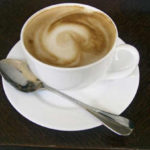
copyright 2009, Art of Living, PrimaMedia,Inc
Here’s a familiar scenario: It’s 7 AM on a Tuesday and you’re making that daily commute when you decide to stop off for a little caffeine laced pick-me-up at a local coffee shop. A hot cup of java to get you over the hump and through another day at the office. So you order a cappuccino, or Americano or macchiato from your local Barista. It’s something you’ve done a millions times before, but have you ever stopped to think about what these words mean? Or from where they originated? Sure, you know that an Americano is an espresso shot with hot water, but why exactly is it called “Americano”? Although these words have morphed into the coffee shop terminology we now commonly use, each one has a distinct origin that differs from their present meanings. Often times we assume these words and phrases are one dimensional but by exploring their genesis we can appreciate these drinks as more than just an eye opener but as the well-crafted beverage that we sometimes take for granted.
Cappuccino may be the most popular coffee house drink in America. A shot of espresso topped off with a layer of foam, served dry with no milk. The ingredients of the drink are well known but cappuccino has a rich and intriguing history dating as far back as Italy in the 19th Century. The name cappuccino is taken from The Order of Friars Minor Capuchin, named so because of their custom of wearing a hood with their habit. In Italian, cappuccino is the diminutive form of the word hood. Although the exact reason of the name is unknown, many believe it is because of the color of the drink, or the foam resting on top of the drink is likened to the hood itself. The first cappuccino machine was patented in Italy in 1901 and the common variation of the cappuccino was perfected by the 1950s.
This drink, like many others originated in Italy and translate into simple terms. The macchiato translates to “marked” or “stained” in Italian. The “stain” refers to the tiny dab of milk on top of the espresso shot. In this case perhaps the more eloquent “macchiato” sounds a lot more appetizing than if you order a small cup of hot “stain”. The dollop of foam was originally added as a way for Baristas to show the serving waiters the difference between an espresso with or without milk.
The Italian Barista serves a much different purpose than his American counterparts. The American Barista is generally just a coffee house employee but in Italy the Barista is revered as an expert in his particular field. Like a ‘coffee sommelier’, the Barista is painstakingly trained in the art of coffee preparation and has an extensive knowledge of coffee beans, their varieties and the espresso machine itself. That certainly puts the high school kid working at your local Starbucks to shame.
Which brings us to our final drink, our country’s namesake, the Americano. This brew originated, like many espresso-based drinks in Italy and consists of an espresso shot and hot water. It’s similar to our traditional American drip coffee but is obviously a much stronger brew. The drink tends to be a bit of an acquired taste and is usually served black, in order to fully appreciate the difference in flavor between it and regular drip coffee.
It’s so often we tend to move through our routines without stopping to appreciate the small details that create the unique aromas and flavors of our coffee shop beverages. Taking the time to smell the roses (or in this case espresso beans) can expand our palettes and give us a thorough understanding of those early morning brews we love so much.
Get your copy of new release The Basic Art of Italian Cooking: Holidays & Special Occasions with over 140 recipes , wine pairing tips, menus and short stories about Holidays spent in Italy.
See you:
Oct 3rd-Collngswood Book Festival, Collingswood NJ for a book signing
Oct 5th- Horsham Township Library-book signing, cooking demo, sampler dinner, reservations limited email:juzz2@aol.com for reservations
Oct 21-Lower Southampton Twp Library, Feasterville, Pa-7 PM- book signing and cooking demo/sampling
Oct 16-18th- Onstage cooking demo, book-signings at Philly Food and Wine Fest
Nov 5-7th-Christmas in Italy weekend at Harvest Moon Bed and Breakfast,. Lancaster, Pa. reservations limited, email: info@harvestmoonbandb.com
Mangia Bene,Vivi Bene,
Maria
![Reblog this post [with Zemanta]](http://img.zemanta.com/reblog_c.png?x-id=0c58b17d-0c66-4722-a65f-d85383fbedf8)
